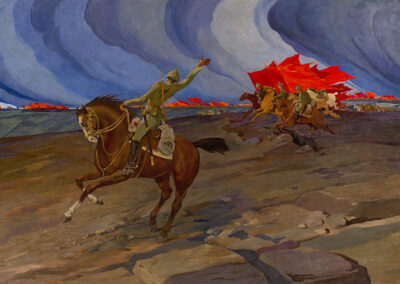Valerian Sidamon-Eristavi
December, 2018
19a Ingorokva Street
Valerian Sidamon-Eristavi, one of the most remarkable and versatile artists of the 1920-1930s, received his education at the Moscow School of Painting, Sculpture and Architecture and had a wide array of interests. Like other Georgian artists of the 1910s, he sought to rely on national forms, which is why he was prone to paint historical themes. In this regard, Sidamon-Eristavi’s works were an exception in the Georgian art scene of the time, looking more like Russian paintings from the late 19th and the beginning of the 20th century, in which the consideration of historical processes could already be felt in academic paintings. In the beginning of his artistic career, his paintings were mostly related to the artists of the Abramtsevo circle and to the art of N. Rerich. By accentuating battle themes, he estranged himself from the representatives of the Russian historical painting school.
During the 1910s and 1920s, apart from pictures dedicated to historical themes, Sidamon-Eristavi created portraits and depicted everyday life situations on canvases, displaying various approaches. His works attest to the fact that there is no unimportant topic or event for him. By employing simple artistic means, he turns a casual event into a significant one – whether it is by generalizing forms, “fixing” the essence of the reflected scenes, depicting platitude with elongated, free brushstrokes, using less contrasting colors accentuated by exceptionally refined, broad stresses, using humor…
The works created by the artist in the 1920s explicitly reveal signs of Expressionist art. Some of the paintings made in this period, such as ‘Red Sowers’, ‘Attack of the Red Horsemen’, ‘Children in the Garden’, clearly reflect the peculiarities of the movement which, due to the transitional social climate, happened to dominate all regions of Europe from the turn of the century until 1925. There is no surprise in the fact that as a patriotically – minded artist, Valerian Sidamon-Eristavi would become an Expressionist artist after the annexation of Georgia by the Soviet Army. For an artist of aristocratic descent, bolshevism meant not only the occupation of his country, but also the destruction of the ancient Georgian aristocracy. His most disturbing and harrowing work is ‘Red Sowers’, painted in the 1920s, a strikingly bold canvas loaded with symbolic and allegoric references. The picture features a soldier on a clear, early spring day, against a background of white blossoming trees, marching heavily on the newly ploughed land towards the onlooker, as if he intended to cross the picture. This man represents the typical new Bolshevik, whose clothes do not bear any military signs. With his broad cheekbones, a short, snubbed nose and a merciless stern appearance, he is depicted with his head turned to one side and staring at something, as if he was studying his future prey. He is followed by youngsters, shown at almost regular intervals. The spots on their bright red shirts are the most visible accents in the picture. The faceless creatures march on their native land with steady, rhythmical steps, sowing Bolshevism…
Maia Tsitsishvili, Nino Tchogoshvili















